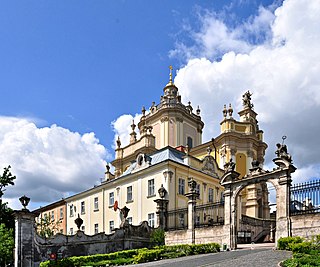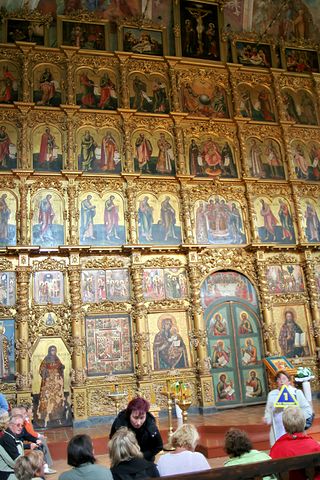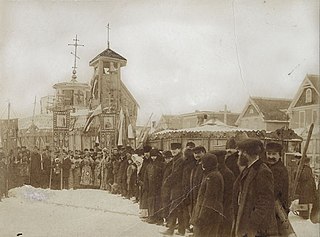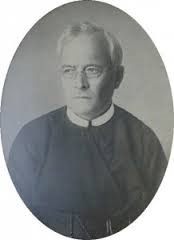Byzantine Rite Christianity in Canada refers to all Eastern Orthodox, Eastern Catholic, and independent groups in Canada who use the Byzantine Rite.
| Part of a series on the |
| Eastern Orthodox Church |
|---|
| |
| Overview |
Byzantine Rite Christianity in Canada refers to all Eastern Orthodox, Eastern Catholic, and independent groups in Canada who use the Byzantine Rite.
It is unclear when Eastern Christians first settled in Canada. Russian Orthodox missionaries from Alaska definitely traversed parts of present-day Canada (they reached Fort Ross, California in 1812), but they do not seem to have created any lasting missions. It is clear that by the 1890s Eastern Christian immigrants began arriving in Western Canada from Eastern Europe.
In 1891, Ukrainian immigrants began to settle in Canada, and they were either Ukrainian Catholic (mostly from Galicia) or Eastern Orthodox (mostly from Bukovina a region under the Romanian Orthodox Church). Very few priests accompanied the settlers, however, "out of deference to the jurisdictional claims of the Russian Orthodox Church" over North America among the Orthodox, and because in 1894 the Catholic Sacred Congregation for the Propagation of the Faith issued a decree forbidding married priests in North America; consequently there are a shortage of Ukrainian priests in Canada. In 1896, a group of Russophile Ukrainians from Wostok, Northwest Territories wrote to the Russian Bishop of Alaska asking for a priest. In 1897, the first recorded Orthodox service was held in Canada at Wostok. Subsequently, Russian Orthodox priests were active in the Ukrainian community, and attracted many converts. The Greek Catholic church's few priests often clashed with Latin administrators such as Bishop Legal. An independent movement separate from the Catholic and Orthodox was founded in Winnipeg around 1903. This movement, backed by the Presbyterian Church, became the Seraphimite Church, and set up the Tin Can Cathedral in Winnipeg.
After 1895, Romanians also began arriving in numbers to the Canadian West, and in 1902 St. Nicholas Romanian Orthodox Church was built in Regina, NWT; it remains standing as one of the oldest buildings in Regina and the oldest Romanian church in North America. [1]
By the turn of the 20th century, immigration from traditionally Eastern Christian countries included not only settlers moving to Western Canada looking for farmland but also those going to Eastern cities, primarily Toronto. The first Byzantine Rite church in that city was the Greek Orthodox Community of St. George, founded in 1909. [2] The first immigrant of Greek origin is reportedly Peter Constantinides [3] who came to Toronto in 1864 to attend the Medical School at the University of Toronto. On May 21, 1909, a meeting was held at the Y.M.C.A. attended by about 200 Greeks living in Toronto. They constituted themselves into a corporate body identified as the "St. George Greek Orthodox Community of Ontario". [4] [5] This was followed by Sts. Cyril and Methody Macedono-Bulgarian Church, founded one year later in 1910 and the Russian Orthodox Church of Christ the Saviour in 1915.
The coming of World War I dramatically affected the Eastern churches in Canada. The Russian Church lost the prestige of government support and in fact came under suspicion of being controlled by the Bolsheviks. Non-Russian ethnic groups set up their own churches in North America. In 1921, Serbian Orthodox parishes in the United States and Canada were reorganized into the Serbian Orthodox Diocese of America and Canada. [6] The Russian church split into the Russian Orthodox Church Outside Russia, the Russian Orthodox Greek Catholic Church in America, the Russian Orthodox Church in America, and some parishes who maintained links with Moscow.
In June 1918, a group of disgruntled Ukrainian Catholic laypeople met to create the Ukrainian Greek Orthodox Brotherhood, which became the Ukrainian Greek Orthodox Church of Canada.

The Eastern Catholic Churches or Oriental Catholic Churches, also called the Eastern-Rite Catholic Churches, Eastern Rite Catholicism, or simply the Eastern Churches, are 23 Eastern Christian autonomous particular churches of the Catholic Church, in full communion with the Pope in Rome. Although they are distinct theologically, liturgically, and historically from the Latin Church, they are all in full communion with it and with each other. Eastern Catholics are a minority within the Catholic Church; of the 1.3 billion Catholics in communion with the Pope, approximately 18 million are members of the eastern churches. The largest numbers of Eastern Catholics may be found in Eastern Europe, Eastern Africa, the Middle East, and India. As of 2022, the Syro-Malabar Church is the largest Eastern Catholic Church, followed by the Ukrainian Greek Catholic Church.

An exarch was the holder of any of various historical offices, some of them being political or military and others being ecclesiastical.

The Ukrainian Greek Catholic Church (UGCC) is a major archiepiscopal sui iuris ("autonomous") Eastern Catholic church that is based in Ukraine. As a particular church of the Catholic Church, it is in full communion with the Holy See. It is the third-largest particular church in the Catholic Church after the Latin Church and the Syro-Malabar Church. The major archbishop presides over the entire Church but is not distinguished with the patriarchal title. The incumbent Major Archbishop is Sviatoslav Shevchuk.

The Byzantine Rite, also known as the Greek Rite or the Rite of Constantinople, is a liturgical rite that is identified with the wide range of cultural, devotional, and canonical practices that developed in the Eastern Christian church of Constantinople.

The Romanian Greek Catholic Church or Romanian Church United with Rome is a sui iuris Eastern Catholic Church, in full union with the Catholic Church. It has the rank of a Major Archiepiscopal Church and it uses the Byzantine liturgical rite in the Romanian language. It is part of the Major Archiepiscopal Churches of the Catholic Church that are not distinguished with a patriarchal title.

Rusyns, also known as Carpatho-Rusyns, Ruthenians, or Rusnaks, are an East Slavic ethnic group from the Eastern Carpathians in Central Europe. They speak Rusyn, an East Slavic language variety, treated variously as either a distinct language or a dialect of the Ukrainian language. As traditional adherents of Eastern Christianity, the majority of Rusyns are Eastern Catholics, though a minority of Rusyns practice Eastern Orthodoxy. Rusyns primarily self-identify as a distinct Slavic people and they are recognized as such in Croatia, Hungary, Poland, Romania, Serbia, and Slovakia, where they have official minority status. Alternatively, some identify more closely with their country of residence, while others are a branch of the Ukrainian people.

The Ruthenian Greek Catholic Church, also known in the United States as the Byzantine Catholic Church, is a sui iuris (autonomous) Eastern Catholic church based in Eastern Europe and North America. As a particular church of the Catholic Church, it is in full communion with the Holy See. It uses the Byzantine Rite for its liturgies, laws, and cultural identity.
The Russian Greek Catholic Church or Russian Byzantine Catholic Church is a sui iuris Byzantine Rite Eastern Catholic Church of the worldwide Catholic Church. Historically, it represents a both a movement away from the control of the Church by the State and towards the reunion of the Russian Orthodox Church with the Catholic Church. It is in full communion with and subject to the authority of the Pope of Rome as defined by Code of Canons of the Eastern Churches.

Alphabetical list of Eastern Christianity-related articles on English Wikipedia

Alexis Georgievich Toth was a Russian Orthodox church leader in the Midwestern United States who, having resigned his position as a Byzantine Catholic priest in the Ruthenian Catholic Church, became responsible for the conversions of approximately 20,000 Eastern Rite Catholics to the Russian Orthodox Church, which contributed to the growth of Eastern Orthodoxy in the United States and the eventual establishment of the Orthodox Church in America. He was glorified by the Orthodox Church in 1994.
Eastern Orthodox Christianity in Ireland is the presence of Eastern Orthodox Christians in the Republic of Ireland. Within Ireland, there are several formally organized parishes belonging to various autocephalous churches, primarily the Ecumenical Patriarchate of Constantinople, the Romanian Orthodox Church, and the Russian Orthodox Church.
Eastern Orthodoxy in North America represents adherents, religious communities, institutions and organizations of Eastern Orthodox Christianity in North America, including the United States, Canada, Mexico, Central America, and the Caribbean. Estimates of the number of Eastern Orthodox adherents in North America vary considerably depending on methodology and generally fall in range from 3 million to 6 million.
The timeline of Eastern Orthodoxy in North America represents a timeline of the historical development of religious communities, institutions and organizations of Eastern Orthodox Christianity in North America.

The Tin Can Cathedral was the first independent Ukrainian church in North America. It was the heart of the Seraphimite Church. Founded in Winnipeg, it had no affiliation with any church in Europe.

Achille Delaere was a Flemish priest who served on the Canadian prairies. He was one of the founders and organizers of the Ukrainian Catholic Church, with the Byzantine-Ukrainian rite, for Ukrainian immigrants in Canada.

The Ordinariate for Byzantine-Rite Catholics in Austria is a Catholic Ordinariate for Eastern Catholic faithful jointly for all Eastern Catholics of Byzantine Rite in the various languages of particular churches sui iuris in Austria.
Saint Sava Serbian Orthodox Parish (Winnipeg) is part of the Serbian Orthodox Eparchy of Canada, a diocese of the Serbian Orthodox Church. It is located at 580 Talbot Avenue in Winnipeg, Manitoba.